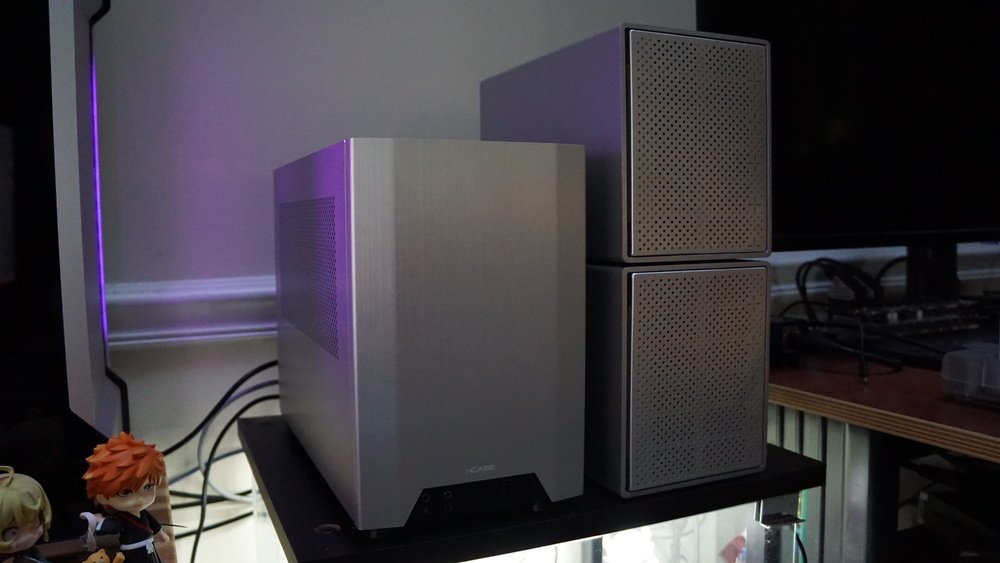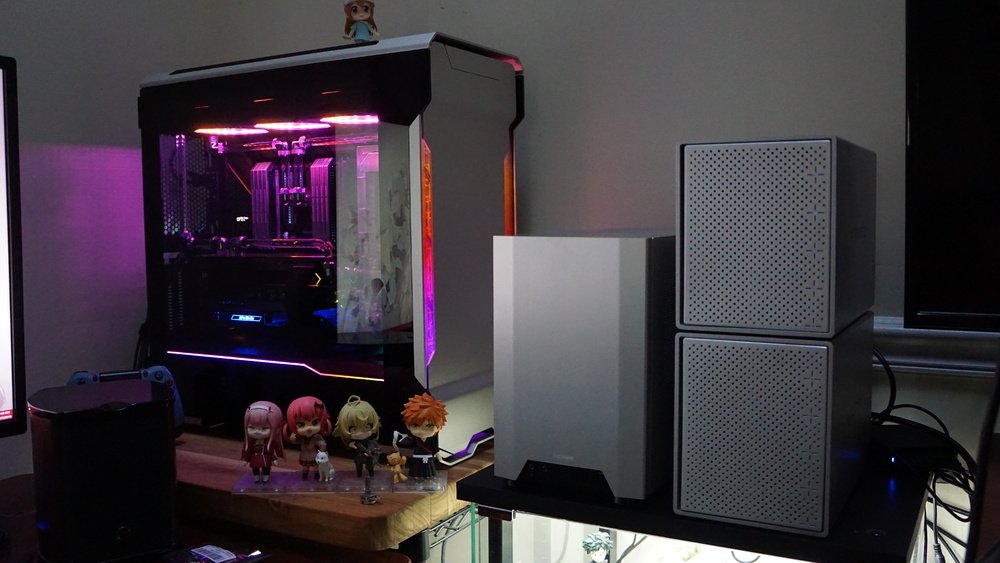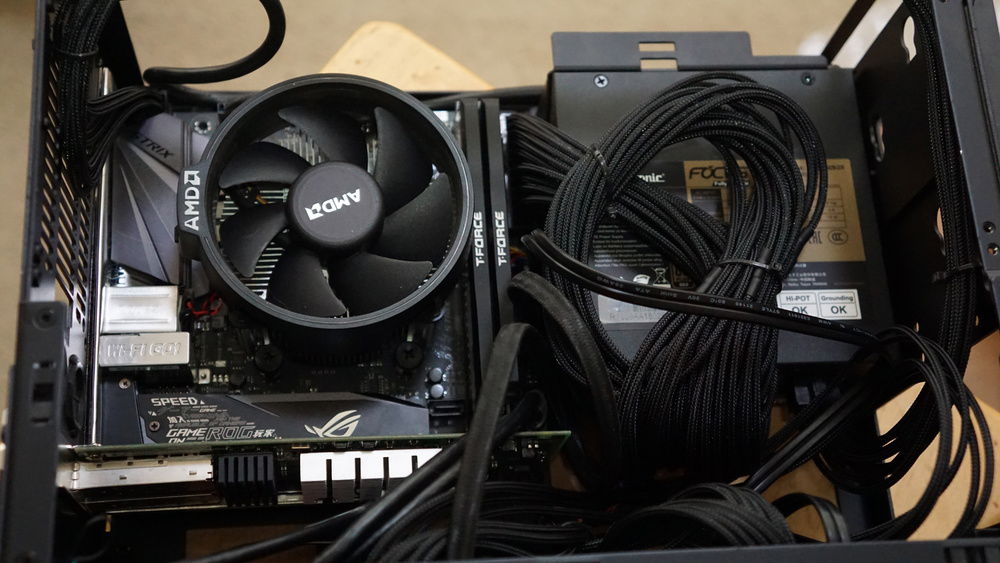The NCASE-M1 mITX Server
This started out as an experiment with some 5-bay USB3 enclosures manufactured by Yottamaster, then turned into a serious server idea. Had an NCASE-M1 case, an X470 motherboard, and a fiber networking card which led me to this craziness. Add a few M.2 SSDs, a couple of SATA SSDs, and you've got yourself a quiet-yet-large amount of storage.
Interesting Stuff
- The case is the NCASE-M1 v5.0. It's minimalistic, and looks nice in the home office. Wanted to keep it in a separate room of the house away from the QNAP NAS it would be storing backups for. It also matches the enclosures, so I'll call it a win.
- Had to go with an AMD Ryzen 2200G because I need the PCIe x16 slot for the network card.
- Waiting on approval in the part list: two Intel 16GB Optane SSDs (P/N: MEMPEK1W016GA)
The Way Stuff Fits Together (Drive-wise)
So, there are 10 hard drives, 2 Intel 16GB NVMe SSDs, and 2 Crucial BX500 240GB SATA SSDs. That's a lot of drives to take care of, but they all work together pretty well.
Write Log (SLOGging through the ZFS Intent Log or ZIL)
This one is a bit complicated, but the quick and dirty*:
There is some write multiplication with respect to the way the hard drives are configured (RAID-Z1). For every write that I need to do, it gets multiplied by 4 due to having this ZFS Intent Log located on the hard drives themselves. This isn't good for the drives, and makes things a bit more painful as you try to write more stuff to the array (with respect to time).
The two Intel 16GB SSDs are there to handle that write multiplication. Instead of writing four times to the hard drives, we write to the SLOG instead which drastically reduces the writes to the drives.
Read Cache (L2ARC)
Since it doesn't really matter if the read cache is there or not, it only gets one Crucial BX500 SSD. It does help to have a read cache, but you won't lose any data if it suddenly decides to quit working. The drives were cheap, and figured it would be a nice thing to add to the array.
Lots of Hard Drives (25TB)
The simple version of this is: all of the hard drives are pooled together in such a way that I get most of the storage space on the hard drives to write stuff on them, but I'm also able to have a hard drive or two die without losing any data.
The much longer version of this: five of the drives (3TB each) will be in a RAID-Z1 `vdev`, and the other five drives (4TB) will be in another `vdev`. Both of these `vdev`s will be added to the main backup pool along with the SLOG and L2ARC mentioned above. Due to overhead and such, this leaves around 25TB of space available for `borg` backups.
Update 1
The last thing that I've been fighting is the 10GbE network card. Unfortunately, the Intel X520-DA2 card wasn't working, so it was replaced with a Mellanox ConnectX-2 10GbE card. After fixing some switch configuration issues, the card is working perfectly and should help speed up the backups as they come over the network.**
Update 2
So, while I have two Intel Optane NVMe drives in the build, I've been trying to figure out why only one of them ever shows up. Come to find out, unless you're rocking a standard Ryzen CPU without integrated graphics and your x16 slot is running in x8 mode, then the motherboard NVMe slot is disabled. I don't like it, but not really and good alternatives at the moment to swap out the motherboard with. Hopefully the X570 fairy will deliver something with a few working NVMe slots...
______
* - ZIL and SLOG are a bit difficult to dive into, but very interesting topics. However, I skipped over quite a bit and glossed over a couple of things, but should be generally accurate.
** - A 1GbE card maxes out at ~125MB per second. A 10GbE card will max out at ~1.2GB per second which makes a big deal transferring over lots of large files.
Interesting Stuff
- The case is the NCASE-M1 v5.0. It's minimalistic, and looks nice in the home office. Wanted to keep it in a separate room of the house away from the QNAP NAS it would be storing backups for. It also matches the enclosures, so I'll call it a win.
- Had to go with an AMD Ryzen 2200G because I need the PCIe x16 slot for the network card.
- Waiting on approval in the part list: two Intel 16GB Optane SSDs (P/N: MEMPEK1W016GA)
The Way Stuff Fits Together (Drive-wise)
So, there are 10 hard drives, 2 Intel 16GB NVMe SSDs, and 2 Crucial BX500 240GB SATA SSDs. That's a lot of drives to take care of, but they all work together pretty well.
Write Log (SLOGging through the ZFS Intent Log or ZIL)
This one is a bit complicated, but the quick and dirty*:
There is some write multiplication with respect to the way the hard drives are configured (RAID-Z1). For every write that I need to do, it gets multiplied by 4 due to having this ZFS Intent Log located on the hard drives themselves. This isn't good for the drives, and makes things a bit more painful as you try to write more stuff to the array (with respect to time).
The two Intel 16GB SSDs are there to handle that write multiplication. Instead of writing four times to the hard drives, we write to the SLOG instead which drastically reduces the writes to the drives.
Read Cache (L2ARC)
Since it doesn't really matter if the read cache is there or not, it only gets one Crucial BX500 SSD. It does help to have a read cache, but you won't lose any data if it suddenly decides to quit working. The drives were cheap, and figured it would be a nice thing to add to the array.
Lots of Hard Drives (25TB)
The simple version of this is: all of the hard drives are pooled together in such a way that I get most of the storage space on the hard drives to write stuff on them, but I'm also able to have a hard drive or two die without losing any data.
The much longer version of this: five of the drives (3TB each) will be in a RAID-Z1 `vdev`, and the other five drives (4TB) will be in another `vdev`. Both of these `vdev`s will be added to the main backup pool along with the SLOG and L2ARC mentioned above. Due to overhead and such, this leaves around 25TB of space available for `borg` backups.
Update 1
The last thing that I've been fighting is the 10GbE network card. Unfortunately, the Intel X520-DA2 card wasn't working, so it was replaced with a Mellanox ConnectX-2 10GbE card. After fixing some switch configuration issues, the card is working perfectly and should help speed up the backups as they come over the network.**
Update 2
So, while I have two Intel Optane NVMe drives in the build, I've been trying to figure out why only one of them ever shows up. Come to find out, unless you're rocking a standard Ryzen CPU without integrated graphics and your x16 slot is running in x8 mode, then the motherboard NVMe slot is disabled. I don't like it, but not really and good alternatives at the moment to swap out the motherboard with. Hopefully the X570 fairy will deliver something with a few working NVMe slots...
______
* - ZIL and SLOG are a bit difficult to dive into, but very interesting topics. However, I skipped over quite a bit and glossed over a couple of things, but should be generally accurate.
** - A 1GbE card maxes out at ~125MB per second. A 10GbE card will max out at ~1.2GB per second which makes a big deal transferring over lots of large files.
Color(s): Silver
RGB Lighting? No
Theme: none
Cooling: Air Cooling
Size: Mini-ITX
Type: General Build
Hardware
CPU
$ 49.99
Motherboard
$ 256.45
Memory
PSU
Case Fan
$ 38.43
Approved by:








